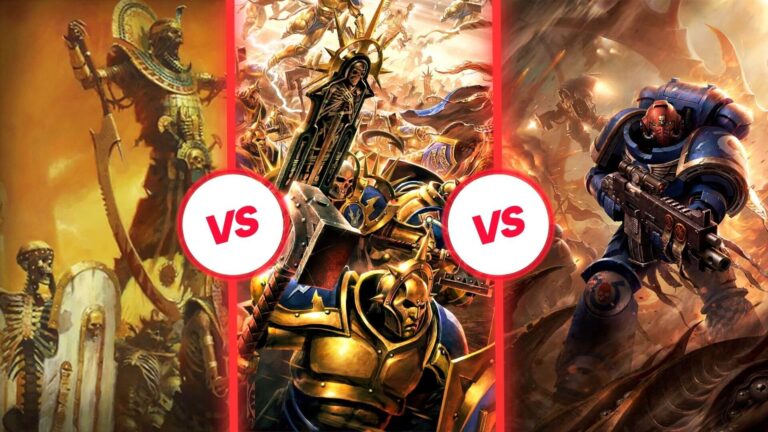Embark on a journey through the realms of high fantasy and far-future sci-fi with Games Workshop’s iconic universes: Warhammer The Old World, Warhammer Age of Sigmar, and Warhammer 40K.
Delve into the intricate lore and captivating narratives of these expansive worlds as we highlight the key distinctions between them.
Table of Contents:
Whether you’re drawn to the clang of swords or the roar of plasma rifles, these three universes have something for everyone.
Differences in Setting and Theme
| Warhammer The Old World | Warhammer Age of Sigmar | Warhammer 40K |
|---|---|---|
| High fantasy world, inspired by Earth’s medieval period mixed with magic. | Mythic realms known as the Mortal Realms, interconnected worlds infused with magic. | Grimdark future where the galaxy is at war, combining sci-fi with dark fantasy elements. |
Warhammer The Old World: A Dive into High Fantasy
Warhammer introduces us to the Old World, a tapestry woven with the threads of high fantasy. This universe is a melting pot of magic, where the arcane is as natural as the air its inhabitants breathe.
Imagine vast forests like Athel Loren, home to the Wood Elves, a race as ancient as they are mysterious, guardians of nature who ally with treemen and forest spirits against encroaching darkness.
The Empire, akin to historical Holy Roman Empire, stands as humanity’s bulwark against Chaos, led by valiant heroes like Karl Franz and wizard lords wielding the winds of magic.
Here, the Skaven, rat-men lurking in the shadows, plot their schemes beneath the cities of men, showcasing the rich variety of stories and conflicts.
Battles are fought with sword, bow, and spell, across landscapes filled with mythical beasts like dragons, griffons, and the undead, raised by necromancers in service to the Vampire Counts of Sylvania.
Each faction, from the stoic Dwarfs in their mountain holds to the marauding Greenskins, contributes to a world brimming with myth and legend.
Warhammer Age of Sigmar: Journey into Mythic Realms
Warhammer Age of Sigmar transports us to the Mortal Realms, where myth and magic reign supreme. These realms, interconnected worlds infused with celestial power, serve as the backdrop for epic battles between celestial warriors, ancient races, and the forces of Chaos, Death, and Destruction.
From the celestial realm of Azyr to the shadowed lands of Shyish, each realm offers a unique setting filled with fantastical landscapes, mythical creatures, and legendary conflicts.
In Age of Sigmar, the theme of myth and magic is omnipresent, shaping the narrative and setting the stage for epic tales of heroism, treachery, and the eternal struggle between Order and Disorder.
Warhammer 40K: The Grim Darkness of the Far Future
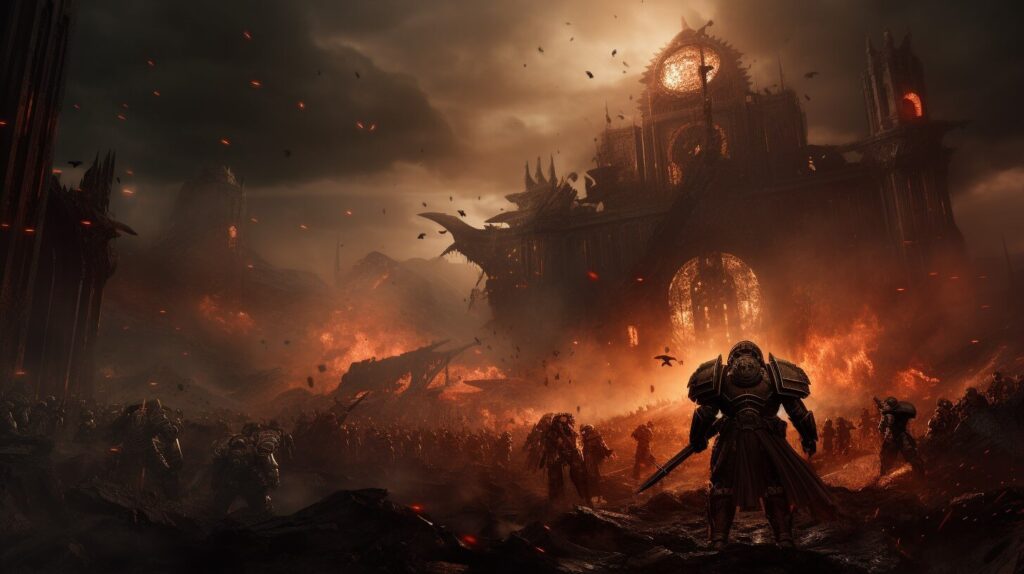
In stark contrast, Warhammer 40K unveils a universe where the fantastical elements of magic are replaced with the equally mysterious and powerful forces of the Warp, a dimension of psychic energy that fuels both space travel and unspeakable horrors.
The Space Marines, genetically modified super-soldiers, serve the Imperium of Man, a galactic empire beset by aliens and heretics. Chapters like the Ultramarines and the Blood Angels are not just warriors but legends, each with a history and culture as rich as any fantasy race.
Alien races such as the Eldar, ancient precursors to humanity with their own psychic abilities, and the Tyranids, a hive-minded species consuming worlds, introduce a scale of conflict that spans galaxies.
The Adeptus Mechanicus, worshippers of the Machine God, blend the lines between technology and religion, showcasing the depth of lore in technology use and development.
Planetary invasions and space battles replace the sieges and skirmishes of the Old World. The Imperium’s vast fleets navigate the Warp, confronting not only physical threats but the ever-present danger of Chaos, where even the mightiest heroes can fall to corruption.
Bringing the Universes to Life
In all three universes, the depth of lore and the complexity of the characters invite players and readers alike into worlds that are as rich and detailed as they are different.
Warhammer The Old World offers an escape to a world where magic and myth breathe life into every forest, mountain, and river.
Warhammer Age of Sigmar beckons adventurers to a realm where magic flows through the very fabric of existence, infusing every corner of the Mortal Realms with wonder and danger.
Warhammer 40K, on the other hand, presents a vision of the future where the struggle for survival and dominion over the stars is as much about the power of technology as it is about the strength of spirit.
Distinct Races and Factions
| Warhammer The Old World | Warhammer Age of Sigmar | Warhammer 40K |
|---|---|---|
| Classic fantasy races like Elves, Dwarfs, Humans, and Orcs. | Celestial warriors like the Stormcast Eternals, ancient races like the Sylvaneth, and diverse factions representing the forces of Order, Chaos, Death, and Destruction. | Futuristic factions including Space Marines, Imperial Guard, Eldar, and Xenos Race such as the Tyranids. |
Warhammer The Old World: The Classic Fantasy Archetypes (and something extra)
Warhammer The Old World is a realm where the archetypes of high fantasy come to life. Noble humans of The Empire, led by the likes of Emperor Karl Franz, stand as a testament to humanity’s resilience and versatility, wielding magic and might to protect their lands from encroaching darkness.
Stout Dwarfs in their mountain holds, such as Karaz-a-Karak, delve deep into the earth, crafting masterworks of metal and stone while nursing long grudges against their myriad foes.
Their battles against Greenskins (Orcs and Goblins) are legendary, filled with a mix of stubborn defense and unmatched craftsmanship in weaponry.
Cunning Elves are split into three main factions: High Elves, safeguarding the world from their island kingdom of Ulthuan; Dark Elves, led by Malekith and harboring a bitter enmity towards their kin; and Wood Elves, mysterious guardians of the forest realm of Athel Loren, who strike swiftly against any who threaten the natural order.
The ever-menacing forces of Chaos, a constant threat to the fabric of reality, bring forth daemons and mortal champions in their quest to engulf the world in perpetual war and madness.
The Undead, whether as the shambling hordes of the Vampire Counts or the ancient legions of the Tomb Kings, weave necromancy into the fray, led by figures like Mannfred von Carstein and Settra the Imperishable.
Warhammer Age of Sigmar: Something OLD, something NEW, Something BLUE
In Warhammer Age of Sigmar, the action bursts forth into a fantastical realm where mighty factions clash for dominance and survival.
The Stormcast Eternals, celestial warriors forged from lightning and courage, stand as the vanguard of order, led by champions like Lord-Celestant Vandus Hammerhand and Neave Blacktalon. Each Stormhost, from the hallowed Hammers of Sigmar to the radiant Celestial Vindicators, brings its own valor and divine purpose to the fray.
Across the Mortal Realms, the forces of Chaos surge forth, embodying the primal forces of destruction and change. From the barbaric hordes of Khorne’s Bloodbound to the twisted machinations of Tzeentch’s Arcanites, Chaos manifests in myriad forms, each seeking to shatter the fragile balance of the realms.
Amidst the tumult, the enigmatic Sylvaneth, children of Alarielle the Everqueen and guardians of the wild places, emerge to defend the natural world against corruption and desecration. Led by mighty Treelords and cunning Branchwyches, they weave the magic of life to reclaim what is rightfully theirs.
But lurking in the shadows are the skittering legions of Death, from the relentless hordes of the Flesh-eater Courts to the spectral hosts of the Nighthaunt. Driven by insatiable hunger or eternal vengeance, they seek to consume or obliterate all that stands in their way.
And beyond even these, ancient powers stir in the depths of the realms, from the elemental fury of the Fyreslayers to the arcane mysteries of the Idoneth Deepkin. Each faction brings its own lore, tactics, and champions to the battlefield, ensuring that every clash is an epic tale waiting to be told.
Warhammer 40K: A Galaxy of Futuristic Factions
In Warhammer 40K, the narrative scope expands to a galactic scale, introducing factions that redefine the boundaries of fantasy and science fiction.
The Space Marines, genetically engineered super-soldiers, serve as the Imperium of Man’s elite warriors. Each chapter, from the Ultramarines under Marneus Calgar to the Blood Angels led by Commander Dante, carries its own unique heritage and heroic sagas.
The vast armies of the Imperium, including the Astra Militarum (Imperial Guard), represent humanity’s unyielding resolve to survive in a galaxy filled with threats, armed with tanks, artillery, and sheer numbers to hold back the darkness.
Enigmatic Eldar, the ancient precursors to humanity, wield psychic powers and advanced technology to navigate the perils of the galaxy, divided into Craftworlds, the dark kin of Commorragh, and the enigmatic Harlequins, each with their own paths and agendas.
Insidious forces of Chaos spill from the Warp, corrupting reality with their demonic legions and mortal followers, echoing the dark fantasy elements of their Warhammer counterparts but on a cosmic scale. The Tyranids, alien hordes beyond comprehension, devour worlds in their quest for biomass, presenting a horror that is both biological and existential.
The Rich Tapestry of War
These factions and their countless stories form the backbone of Warhammer: TOW, Age of Sigmar and Warhammer 40K, offering players and fans a universe teeming with lore, battles, and the eternal struggle for power and survival. The diversity of factions not only enriches the narrative but also highlights the universes’ themes of alliance, betrayal, and the relentless pursuit of dominance.
Technology versus Magic
| Warhammer The Old World | Warhammer Age of Sigmar | Warhammer 40K |
|---|---|---|
| Focus on magic and medieval technology. | Each realm possessing its own magical essence. Celestial beings wield divine power alongside ancient artifacts and enchanted weaponry. | Advanced technology and psychic powers play a central role. |
Warhammer The Old World: The Arcane Pulse of Magic
In the realm of Warhammer The Old World, magic is as vital to the fabric of reality as the air its inhabitants breathe. Wizards, sorcerers, and magical beings draw upon the Winds of Magic, a force that flows from the Realm of Chaos, weaving spells that can turn the tide of entire battles.
From the mighty Colleges of Magic in The Empire, where wizards specialize in different forms of magic, to the dark sorceries wielded by the Vampire Counts and Chaos sorcerers, magic is a tool and weapon wielded with awe-inspiring effect.
This universe is a place where a single spell can summon storms, breathe life into the dead, or cloak armies in invisibility. Heroes like Teclis, the High Elf Archmage, and Nagash, the Supreme Lord of the Undead, exemplify the pinnacle of magical prowess, their legendary deeds woven into the lore of the Old World.
Despite the prominence of magic, the technology of Warhammer remains grounded in a medieval setting, enhanced by fantastical elements.
Dwarfs, for example, combine their unrivaled craftsmanship with gunpowder to create war machines like cannons and gyrocopters, showcasing a blend of magic and rudimentary technology that maintains the high fantasy atmosphere.
Warhammer Age of Sigmar: The Essence of Magic and Martial Might
In contrast, Warhammer Age of Sigmar shines a spotlight on the primal forces of magic and martial prowess, where the fate of realms hangs in the balance amidst epic clashes of power.
Magic pulses through the very fabric of reality, woven by wizards and sorcerers who harness its energies to reshape the battlefield. From the fiery incantations of the Fyreslayers to the eldritch spells of the Tzeentchian Arcanites, each faction channels magic in unique and awe-inspiring ways.
But it’s not just spells and incantations that shape the conflict; martial might plays an equally crucial role. Mighty heroes lead their armies into battle, wielding legendary weapons and displaying unmatched skill in combat.
Whether it’s the thunderous charge of the Stormcast Eternals or the cunning tactics of the Sylvaneth, martial prowess is a cornerstone of warfare in the Mortal Realms.
Among the factions, the Seraphon stand out as celestial warriors infused with the power of the stars themselves. Led by ancient Slann Starmasters, they descend from the heavens to strike down their foes with celestial fury, their very presence inspiring awe and fear in equal measure.
Warhammer 40K: The Supremacy of Technology and Psychic Might
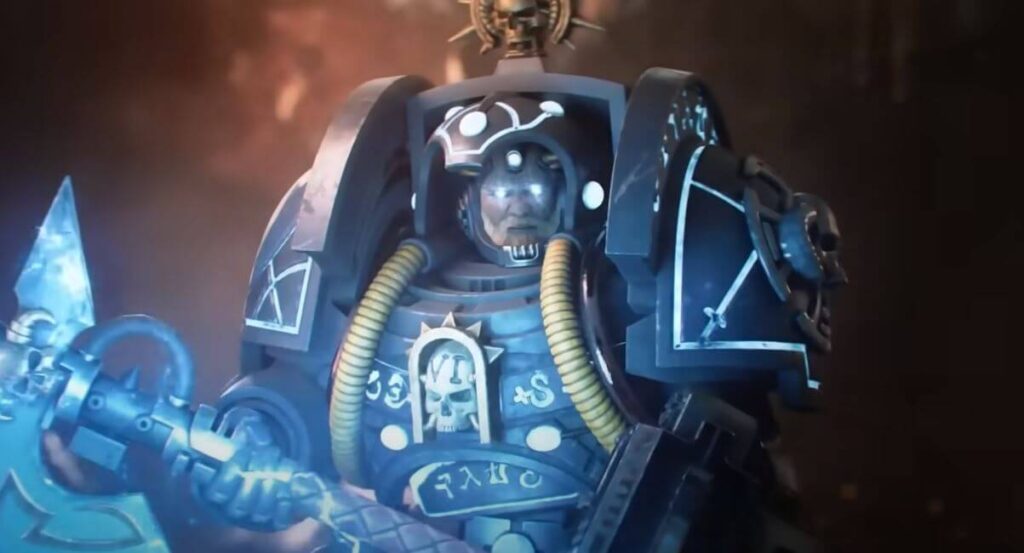
Conversely, Warhammer 40K thrusts technology into the limelight, presenting a universe where humanity’s survival hinges on the might of its machines and the depth of its ingenuity.
Space travel, powered by the Warp, allows for the vast distances between stars to be bridged, while energy weapons and power armor define the combat of the future. The iconic Space Marines, encased in their formidable suits of power armor and wielding bolters, are a testament to the Imperium’s technological prowess.
Yet, in this universe, the supernatural is not forgotten but transformed into psychic powers. Psykers, individuals capable of tapping into the Warp, wield abilities that mirror the magic of Warhammer Fantasy, but with a distinctly sci-fi flavor.
These powers can shield allies, tear holes in reality, or incinerate foes, adding a layer of complexity to the battlefield that echoes the mystical without abandoning the science fiction setting.
The Adeptus Mechanicus, a techno-religious faction, venerates the Machine God, pursuing knowledge and technology as a form of worship. Their pursuit of archeotech, lost technology from humanity’s golden age, and the creation of towering Titans and Skitarii legions exemplify the blend of faith and technology unique to the 40K universe.
Magic and Technology: Two Sides of the Same Coin
Both Warhammer and Warhammer 40K celebrate the extraordinary, whether through the arcane arts or the marvels of technology. These elements not only define the aesthetic and narrative of each universe but also shape their strategies and conflicts.
Magic in Warhammer The Old World and Age of Sigmar brings a sense of wonder and unpredictability, rooted in a world where legends breathe.
In contrast, Warhammer 40K’s technology emphasizes mankind’s reliance on its creations to navigate a hostile galaxy, where psychic powers provide a bridge to the mystical past.
Differences in Scale and Warfare
| Warhammer The Old World | Warhammer Age Of Sigmar | Warhammer 40K |
|---|---|---|
| Battles take place across continents, emphasizing melee combat and magic. | The conflict spans across realms, with battles ranging from skirmishes to cataclysmic clashes. | Galactic scale conflicts involving space battles and planet-wide wars. |
Warhammer The Old World: Battles Rooted in History and Myth
In the fantastic and old world of Warhammer, the landscapes are as much a character in the tales of war as the heroes and villains themselves.
The Old World, with its rich tapestry of environments—from the dense, mysterious forests of Athel Loren, home to the enigmatic Wood Elves, to the snow-capped peaks of the World’s Edge Mountains, stronghold of the Dwarfs—provides a stage for epic narratives.
Sieges of towering castles, such as those defending the Empire from the forces of Chaos, are battles where history and heroism intersect. The mighty fortress of Altdorf stands not just as a symbol of human resilience but as a testament to the battles that have shaped the land.
Clashes in dark forests, where every shadow could conceal friend or foe, add layers of strategy and suspense, as seen in the ambushes laid by Beastmen or the swift strikes of Wood Elves against invaders.
These battles, while grand, maintain a personal connection to the land and its lore. Each conflict is a chapter in a larger saga, rooted in the history, culture, and very essence of the races that inhabit the Old World.
This connection imbues battles with a sense of weight and consequence, where victories and defeats are etched into the memory of the land itself.
Warhammer Age of Sigmar: Battles Across the Mortal Realms
In contrast, Warhammer Age of Sigmar presents a stage where warfare unfolds across the vast and diverse landscapes of the Mortal Realms, each realm a unique battleground shaped by its own magical essence and history.
From the fiery landscapes of Aqshy to the deathly swamps of Ghyran, the Mortal Realms offer a rich tapestry of environments where armies clash for dominion. Every battlefield tells a story, whether it’s the ancient ruins of Shyish haunted by the spirits of the dead or the verdant forests of Ghur teeming with primal beasts.
But warfare in the Mortal Realms is not just about territorial conquest; it’s a struggle for the very soul of existence. Chaos forces seek to corrupt and destroy, while Order factions strive to maintain balance and harmony. Death and Destruction, each with their own agendas, add further layers of complexity to the conflict, turning every engagement into a battle for survival and supremacy.
Yet amidst the chaos and carnage, heroes emerge to lead their armies to victory. Mighty champions like the Lord-Celestants of the Stormcast Eternals or the Fungoid Cave-Shamans of the Gloomspite Gitz inspire their followers with acts of bravery and cunning, shaping the course of battles and the destiny of realms.
Warhammer 40K: Warfare on a Cosmic Scale
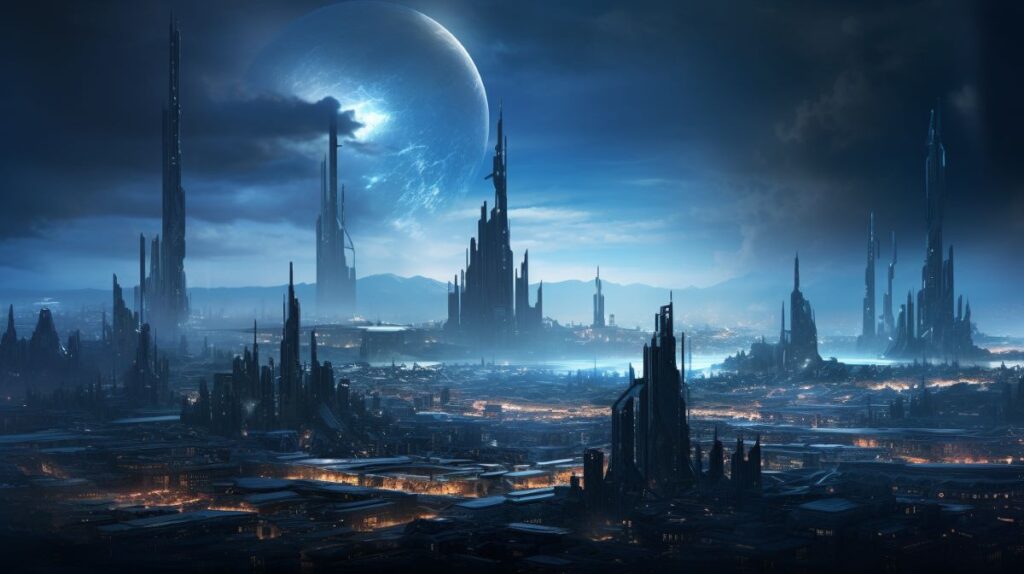
Contrastingly, Warhammer 40K elevates warfare to a galactic theatre, where the stakes are not just the fate of a kingdom or forest but of entire planets and systems. The immense scope of these conflicts brings into play a variety of environments, from the desolate, war-torn landscapes of Armageddon to the labyrinthine hive cities of Necromunda.
In this universe, battles are not confined to the surface of worlds; they extend into the void of space, where Imperial fleets clash with the starships of Chaos, Orks, and other alien races. The scale of warfare is staggering, with each engagement part of a ceaseless struggle for survival, dominance, and the very soul of the galaxy.
The galactic scale of Warhammer 40K’s conflicts adds a layer of complexity and grandeur to the narrative. Planets become battlegrounds where every victory or loss can shift the balance of power across the stars. Yet, despite the vastness of the theatre of war, individual acts of heroism and villainy stand out, illustrating that in the vast darkness of the future, the actions of a single person or squad can still change the course of history.
Three Visions of Conflict
The comparison between the battles of Warhammer and Warhammer 40K underscores the thematic diversity that makes each universe compelling.
Warhammer The Old World offers a more intimate portrayal of conflict, where the land and its history play a crucial role, and battles feel like part of an ongoing saga of the Old World.
In Warhammer Age of Sigmar, the battles across the Mortal Realms are not just fights for territory; they are struggles for the very essence of existence, where every victory and defeat resonates across the fabric of reality itself.
Warhammer 40K, on the other hand, presents a vision of warfare on an unimaginable scale, where the fate of galaxies hangs in the balance, yet individual courage and cunning can still tip the scales.
Contrasts in Lore and Story
| Warhammer The Old World | Warhammer Age of Sigmar | Warhammer 40K |
|---|---|---|
| Rich with myths, legends, and a deep history of the Old World. | A new era of mythic storytelling, chronicling the struggles of celestial warriors against the forces of Chaos, Death, and Destruction. | Expansive lore covering millennia, with complex narratives of survival, war, and the cosmos. |
Warhammer The Old World: A Tapestry of Myths and Legends
In Warhammer FThe Old Lore the lore is a dense weave of history, myth, and legend, where the land itself is as storied as the characters who traverse it. Each race within the Old World carries its own set of sagas that speak to its history, culture, and place within the larger narrative.
For example, the Empire, with its human-centric stories, reflects themes of resilience and diversity, embodied in heroes like Sigmar, the god-king and founder.
The Dwarfs have their Book of Grudges, chronicling the wrongs done to them across the ages, a testament to their long memory and stubborn nature. Elves, split into High, Dark, and Wood, have tales of kinship and betrayal, weaving a complex narrative of elegance, power, and loss.
This lore is not just background; it influences the motivations, alliances, and enmities that drive the conflicts within the game.
Legendary battles, such as the War of the Beard between Dwarfs and High Elves, are not merely historical footnotes but pivotal events that shape the present, informing the deep-seated mistrust between these races.
Warhammer Age of Sigmar: A Symphony of Realms and Rivalries
Warhammer Age of Sigmar immerses players in a rich tapestry of realms, where ancient myths and epic legends intertwine to shape the fate of civilizations. Each faction within the Mortal Realms possesses its own compelling narrative, reflecting diverse cultures, ambitions, and struggles.
Take, for instance, the Stormcast Eternals, forged in celestial lightning and bound by divine purpose. Their saga mirrors themes of redemption and sacrifice, embodied by leaders like Lord-Celestant Vandus Hammerhand, whose valor inspires legions to stand against the forces of darkness.
Similarly, the Sylvaneth, guardians of the wild places, carry tales of rebirth and renewal amidst the ever-changing seasons of the realm. Led by the resplendent Alarielle the Everqueen, they fight to preserve the balance of nature against the encroaching darkness.
Meanwhile, the insidious forces of Chaos sow discord and corruption across the realms, driven by ancient grudges and thirst for power. From the brutal Bloodbound of Khorne to the cunning disciples of Tzeentch, each faction embodies the chaotic forces that threaten to unravel the fabric of reality itself.
But amidst the chaos and conflict, alliances are forged and heroes rise to confront the darkness. Whether it’s the unlikely partnership between the Freeguilds and the Dispossessed or the fierce unity of the Ironjawz, the Mortal Realms are a crucible where friendships are tested, and legends are made.
Warhammer 40K: Epic Sagas Across Time and Space
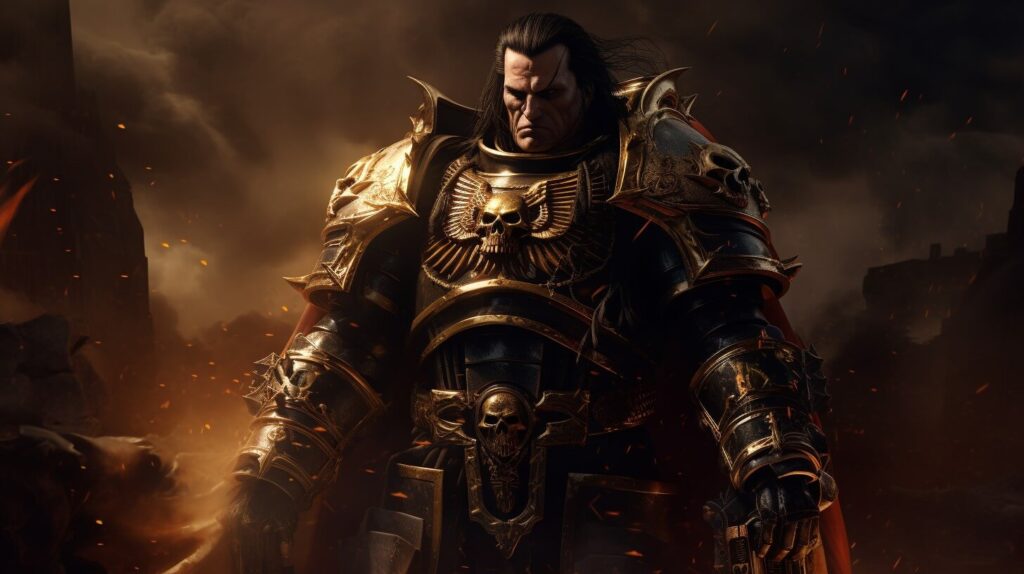
Warhammer 40K takes the narrative scope to an entirely different level, spanning the galaxy and millennia. It’s a universe where the grandeur of empires is juxtaposed with the personal stories of those who inhabit it, from the god-like Emperor of Mankind to the humblest guardsman fighting in the trenches.
The lore encompasses the rise and fall of civilizations, like the Eldar, whose overindulgence spawned the Chaos God Slaanesh, altering the fabric of the galaxy and leading to the creation of the Eye of Terror.
The Imperium of Man, a galactic empire teetering on the brink of collapse, is a bastion against the darkness, its history a grim tale of sacrifice, zealotry, and the endless war for survival.
The struggle against Chaos, a constant across both universes, takes on cosmic significance in 40K, with Daemonic incursions threatening reality itself.
The lore of the Space Marines, divided into chapters each with its own culture and traditions, showcases the diversity and complexity of the human experience in the 41st millennium.
A Multiverse of Stories
Warhammer TOW, Age of Sigmar and Warhammer 40K offer narratives that are as deep and complex as the worlds they inhabit.
In Warhammer, the lore is intimately tied to the magical and mythical landscape of the Old World, providing a backdrop for tales of heroism, treachery, and the eternal struggle against Chaos.
In Warhammer Age of Sigmar, the stories of heroes and villains, triumphs and tragedies, weave together to create a vibrant and dynamic world where every battle is a chapter in an epic saga of gods and mortals, magic and mayhem.
In Warhammer 40K, the lore expands to a galactic scale, where the stakes are not just the fate of a kingdom or a world, but of humanity and countless other species across the stars.

